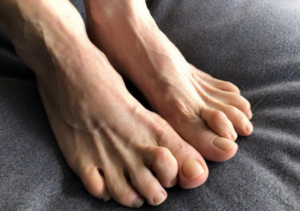Hammer toes are a foot deformity characterized by abnormal bending of the toe joints, causing the affected toes to resemble a hammer or claw. This condition can lead to pain, discomfort, and difficulty wearing shoes.
Causes of Hammer Toes
- Muscle Imbalance: Imbalance between the muscles and tendons that control toe movement.
- Toe Trauma: Previous injury or trauma to the toes can contribute to deformity.
- Footwear: Wearing shoes that are too narrow, high-heeled, or too tight can force toes into an unnatural position.
- Genetics: Some individuals may have an inherited predisposition to develop hammer toes.
- Arthritis: Joint inflammation and stiffness can affect toe alignment.

